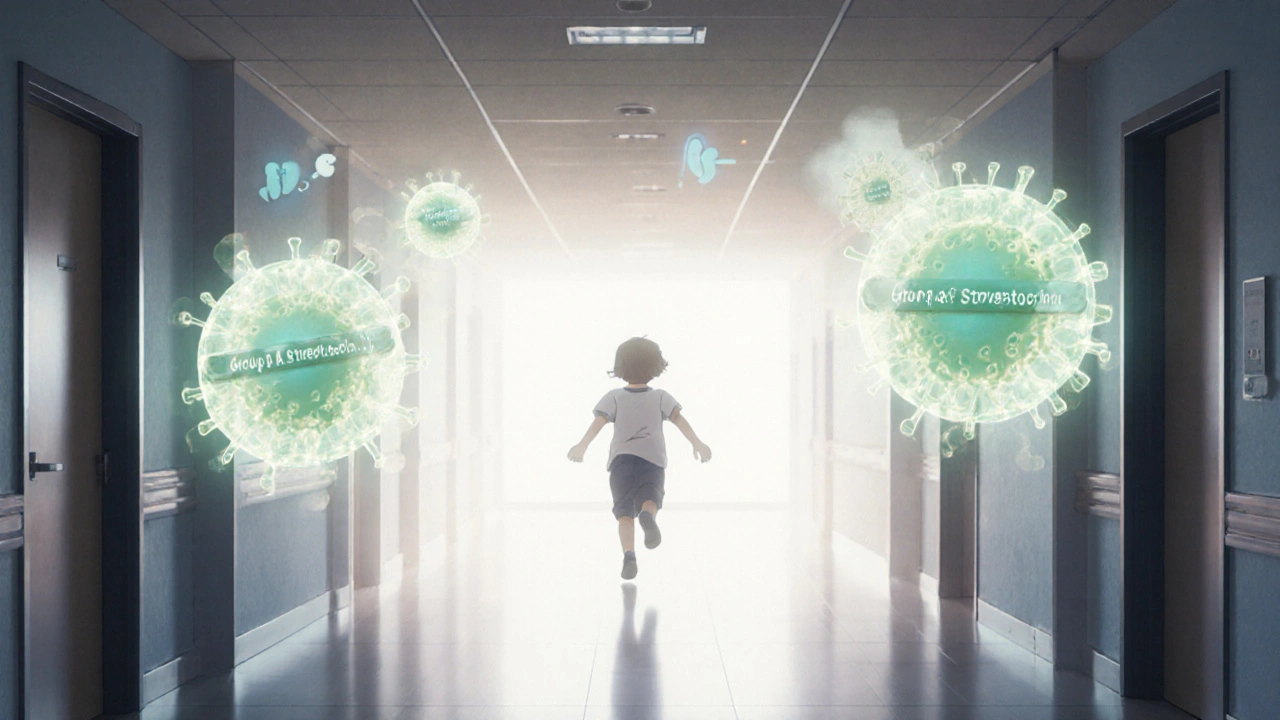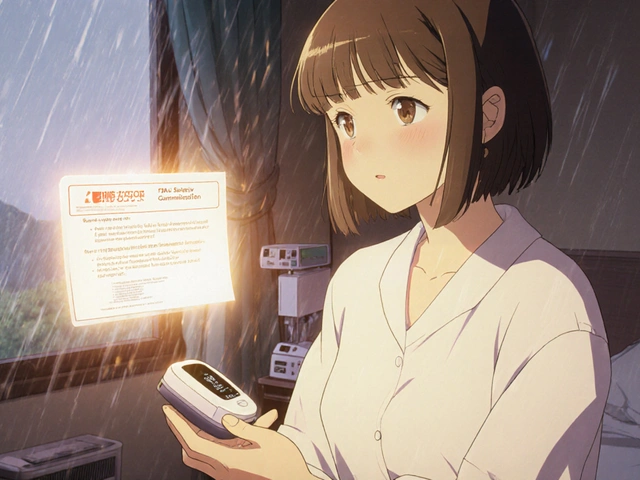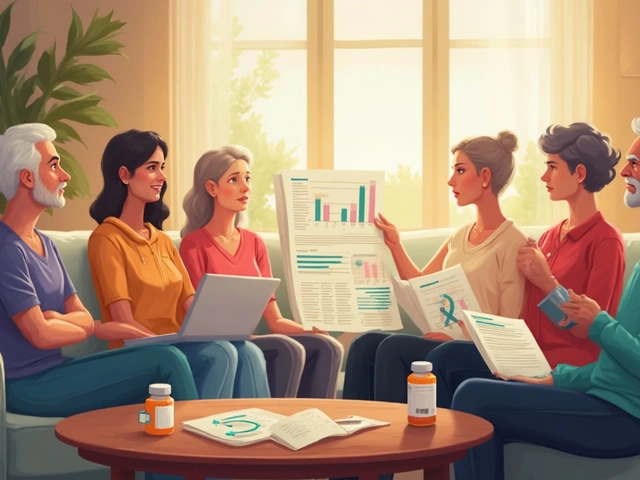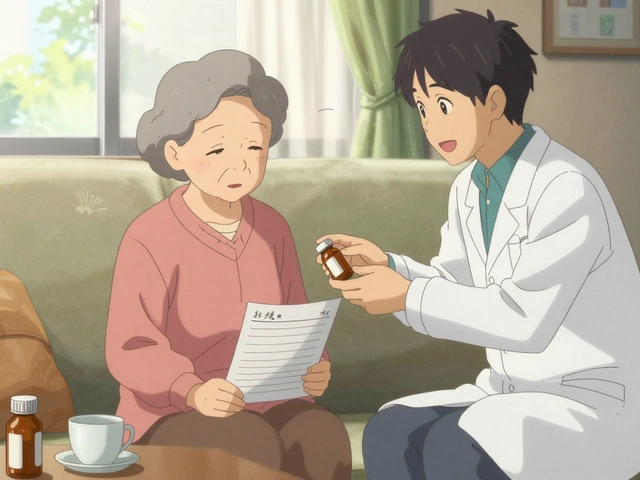Strep throat isn’t just a sore throat. It’s a bacterial infection caused by Group A Streptococcus (Streptococcus pyogenes), and if left untreated, it can lead to serious complications like rheumatic fever or kidney inflammation. Unlike viral sore throats that come with coughs and runny noses, strep throat hits fast and hard-often without warning. If you or your child has a sudden, severe throat pain, fever, and no cough, it’s worth getting checked. The good news? With the right diagnosis and treatment, most people feel better in just a couple of days.
How Doctors Tell Strep Throat from a Virus
Not every sore throat is strep. In fact, up to 80% of adult sore throats are caused by viruses like the common cold or flu. So how do doctors know which is which? They look for a specific pattern of symptoms.
Strep throat typically shows up with:
- Sudden, intense throat pain
- Fever above 100.4°F (38°C)
- White patches or pus on the tonsils
- Tender, swollen lymph nodes in the neck
- Red spots on the roof of the mouth (palatal petechiae)
- No cough, no runny nose, no hoarseness
The absence of a cough is actually one of the strongest clues. Studies show that if you have a cough along with your sore throat, there’s less than a 10% chance it’s strep. This is why doctors use the Centor criteria-a simple scoring system that adds up key signs. One point each for: no cough, fever, swollen neck glands, and tonsil exudate. A score of 3 or higher means you likely need a test.
But symptoms alone aren’t enough. That’s why testing is critical. There are two main types of tests:
- Rapid antigen test (RADT): A quick swab of the back of your throat gives results in 10 to 30 minutes. It’s accurate in 95% of cases when it’s positive, but it can miss about 10% of true strep infections-especially in kids.
- Throat culture: The gold standard. If the rapid test is negative and the doctor still suspects strep (especially in children), they’ll send a sample to the lab. Results take 1 to 2 days, but it catches nearly all cases.
- Molecular (PCR) test: Newer, more sensitive, and increasingly common. It detects the bacteria’s DNA and is 95-98% accurate. Turnaround time is usually 24 to 48 hours.
The CDC recommends confirming negative rapid tests in kids and teens because they’re at higher risk for complications. For healthy adults with low Centor scores, a negative rapid test may be enough to rule out strep without further testing.
Which Antibiotics Are Used-and Why
Antibiotics aren’t just for feeling better faster. They prevent serious complications. Left untreated, about 3% of strep cases can lead to rheumatic fever, a condition that damages heart valves and can cause lifelong problems. That’s why treatment is non-negotiable.
The first-line antibiotic is still penicillin V or amoxicillin. Why? Because after 70 years of use, Group A Streptococcus has almost no resistance to them. The eradication rate is 95% when taken correctly.
For adults, the standard dose is 500 mg of penicillin V twice a day for 10 days. Kids get lower doses based on weight. Amoxicillin is often preferred for children because it tastes better and is taken once a day. A single 50 mg/kg dose (up to 1,000 mg) works just as well as multiple doses.
If you’re allergic to penicillin, options include:
- Cephalexin (a cephalosporin) - 20 mg/kg twice daily
- Clindamycin - 7 mg/kg three times daily
- Azithromycin - 12 mg/kg once daily for 5 days
But here’s the catch: macrolides like azithromycin have rising resistance rates-up to 15% in some areas. Clindamycin resistance is also creeping up. That’s why these are second-line options, not first. The goal is to use the most effective, least resistant drug possible.
Antibiotics don’t just cure you-they stop you from spreading the infection. Within 24 hours of starting treatment, you’re no longer contagious. That’s why you can return to school or work after one full day of antibiotics, as long as your fever is gone.
What the Recovery Timeline Actually Looks Like
Most people start feeling better within 24 to 48 hours after starting antibiotics. The fever drops, swallowing gets easier, and energy returns. But feeling better doesn’t mean you’re done.
Here’s what to expect:
- Day 1: Start antibiotics. Fever may still be present, but throat pain begins to ease.
- Day 2: Significant improvement. Most people can eat and drink normally again.
- Day 3-4: Symptoms continue to fade. Swollen glands may still be tender.
- Day 5-7: Almost back to normal. Any lingering soreness is mild.
- Day 10: Finish the full course-even if you feel great. Stopping early increases relapse risk.
Without antibiotics, symptoms usually last 7 to 10 days, and you remain contagious the whole time. Worse, the risk of complications rises sharply after day 4.
Relapse happens in 5% to 15% of cases-and it’s almost always because the antibiotic course wasn’t finished. A 2023 study in JAMA Pediatrics found that 40% of parents stop antibiotics when their child seems better. That’s a dangerous habit. Even if you feel fine, the bacteria may still be hiding in your throat.
Also, don’t be fooled by lingering symptoms. A mild sore throat or fatigue for a few extra days after finishing antibiotics is normal. But if your fever comes back, your throat swells again, or you develop a rash, ear pain, or difficulty breathing, see a doctor immediately. These could signal complications like a peritonsillar abscess (a pus-filled pocket near the tonsil), which affects 1-2% of untreated cases.

Why You Shouldn’t Use Old Antibiotics or Share Them
One of the biggest mistakes people make is using leftover antibiotics from a previous illness. Maybe you had strep last winter and still have some amoxicillin in the cabinet. Tempting? Yes. Safe? No.
First, the antibiotic may not be the right one. Strep needs a 10-day course of penicillin or amoxicillin. If you take a 5-day course of something else, you’re not treating it properly.
Second, you might be allergic. You didn’t know you were allergic to penicillin last time? You might be now.
And third, it fuels antibiotic resistance. The CDC reports that 12% of adults have used leftover antibiotics for a new infection. That’s one in eight people contributing to the rise of superbugs.
Same goes for sharing. A 2024 Reddit survey found 8% of adults admitted to giving antibiotics to family members. That’s not helpful-it’s dangerous. You’re not just risking your own health-you’re putting others at risk for treatment failure and resistant strains.
What’s New in Strep Throat Treatment
There’s exciting progress on the horizon. In March 2024, the FDA approved a new rapid test called Strep Ultra. It uses molecular technology to detect strep in 15 minutes with 98% accuracy. This could replace older rapid tests soon, especially in urgent care centers and schools.
Researchers are also testing whether a 5-day antibiotic course could work as well as the traditional 10-day one. Early results from a multi-center trial (NCT05678901) suggest it might, especially with amoxicillin. If confirmed, this could improve compliance and reduce side effects like diarrhea or yeast infections.
But the biggest challenge remains: prevention. There’s no vaccine for strep throat yet. Scientists are working on one, but the bacteria has over 200 different strains, each with a slightly different surface protein. Making a vaccine that covers them all is like trying to catch 200 different birds with one net.
For now, the best defense is smart diagnosis and full antibiotic courses. The WHO has listed rheumatic heart disease prevention as a global priority. That means better testing, better education, and better adherence to treatment.

When to Worry: Red Flags Beyond the Sore Throat
Most strep throat cases are straightforward. But watch for these warning signs:
- Fever returning after 2-3 days of antibiotics
- Difficulty swallowing or breathing
- Swelling on one side of the throat
- Joint pain, rash, or swelling in other parts of the body
- Dark urine or swelling in the face or legs (signs of kidney involvement)
These could mean complications like:
- Peritonsillar abscess - a pocket of pus behind the tonsil
- Rheumatic fever - can damage heart valves
- Post-streptococcal glomerulonephritis - kidney inflammation
If you or your child has any of these, don’t wait. Go to urgent care or the ER. Early intervention prevents long-term damage.
Prevention Tips That Actually Work
Strep spreads through droplets-coughs, sneezes, shared utensils. You can’t avoid it completely, but you can reduce risk:
- Wash hands often with soap and water
- Avoid sharing drinks, food, or toothbrushes
- Replace your toothbrush after 24 hours of starting antibiotics
- Keep kids home until they’ve been on antibiotics for 24 hours
- Don’t pressure doctors for antibiotics if you have a cough or runny nose
The CDC says 30% of antibiotic prescriptions for sore throats are unnecessary. That’s not just wasteful-it’s harmful. Antibiotics don’t help viruses. They just train bacteria to fight back.
Can you get strep throat without a fever?
Yes, but it’s uncommon. Fever is present in about 85% of confirmed strep cases. If you have a sore throat with no fever, it’s more likely viral. However, some people-especially older adults or those with weakened immune systems-may not run a high fever. If other symptoms like swollen glands or pus on tonsils are present, testing is still recommended.
Is strep throat more common in winter?
Yes. Strep throat peaks between November and April, with infection rates 30% higher during colder months. This is likely due to people spending more time indoors in close contact, making transmission easier. Out-of-season cases have increased slightly in recent years, possibly linked to climate shifts, but winter remains the highest-risk season.
Can a rapid strep test be wrong?
Yes. Rapid tests are very good at spotting strep when it’s there (95% specificity), but they miss about 10-15% of cases, especially in young children. That’s why negative results in kids and teens are often followed up with a throat culture. False negatives are less common in adults, so doctors may rely on the rapid test alone if symptoms are mild and Centor score is low.
Why is penicillin still the first choice if it’s so old?
Because it still works. Despite decades of use, less than 0.5% of Group A Streptococcus strains are resistant to penicillin. Newer antibiotics have higher resistance rates-up to 15% for azithromycin. Penicillin is also cheap, safe, and has fewer side effects. It’s not outdated-it’s proven.
How long should I stay home from work or school?
Stay home until you’ve taken antibiotics for at least 24 hours and your fever is gone. You’re no longer contagious after that point. Even if you still feel a little sore, you can return to normal activities. Just make sure you finish your full 10-day course.
Can you get strep throat more than once?
Yes. Having strep once doesn’t give you lifelong immunity. You can get it again, especially if you’re exposed to someone else who’s infected. Children are more likely to get repeated cases. If you or your child has more than seven episodes in a year, an ENT specialist may evaluate whether tonsil removal is needed.
Final Takeaway: Don’t Guess-Test and Treat Right
Strep throat is simple to treat-but only if you get the diagnosis right. Don’t assume your sore throat is strep just because it hurts. Don’t take leftover antibiotics because you think you’ve had it before. And don’t stop the medicine just because you feel better.
The best outcome comes from three things: recognizing the signs, getting tested when needed, and finishing every pill. That’s how you protect yourself, your family, and the future effectiveness of antibiotics.







Comments
Arup Kuri
So now we're supposed to trust the CDC and doctors who push penicillin like it's holy water? LOL. I've seen people get rashes from amoxicillin and still be told to keep taking it. Meanwhile, the pharma giants are laughing all the way to the bank. Ever heard of herbal throat sprays? Garlic oil? Honey and turmeric? They work better than antibiotics and don't turn your gut into a war zone. They just don't patent natural stuff so you're stuck with the chemical crap. And don't even get me started on how they test kids - swabbing their throat like it's a crime scene. Next they'll be fingerprinting toddlers for strep.
Elise Lakey
I really appreciate how clear this breakdown is - especially the part about the Centor criteria and why a cough rules out strep. I had no idea the absence of cough was such a strong indicator. My daughter had a sore throat last month and we assumed it was strep because she was feverish, but she also had a slight runny nose. Turns out it was viral. I’m so glad we didn’t push for antibiotics. I also didn’t know about replacing the toothbrush after 24 hours - that’s a tiny detail that could make a big difference. Thank you for including the research citations too. It makes it feel trustworthy.
Sharley Agarwal
Antibiotics are poison. They kill your gut. They make you weak. They’re a scam. Don’t take them unless you’re dying. And even then, maybe don’t.
prasad gaude
In India, we have a saying: ‘Dard hai toh dawa lena padega’ - if there’s pain, you must take medicine. But here’s the thing - we’ve been taking medicine without asking why. I remember my uncle taking ciprofloxacin for a sore throat because his friend said it worked last time. He got diarrhea for a month. And now? His body doesn’t respond to anything. We’re not just treating throats - we’re training bacteria to be superheroes. And the worst part? We think we’re being smart by using what’s left in the cupboard. But in truth, we’re playing Russian roulette with the future of medicine. I’ve seen grandmas in villages use turmeric paste and warm salt water - and they recover. Not always fast, but they recover. Maybe we don’t need to rush to the clinic every time our throat hurts. Maybe we need to learn to listen to our bodies - not just our pharmacies.